#channing pollock
Photo

(vía Weimar: Behind the Scene)
Channing Pollock makes a dramatic entrance in Georges Franju’s Judex (1963)
4 notes
·
View notes
Text
The Original Channing Pollock
Your correspondent is one of the few people who requires the specificity that characterizes this post’s title. There was a later Channing Pollock, a magician who lived from 1926 through 2006. Obviously that later one was named after the ORIGINAL Channing Pollock (1880-1946), playwright, critic, lecturer, and a guy I should have written about a long time ago.
Pollock was the son of a career…

View On WordPress
1 note
·
View note
Text
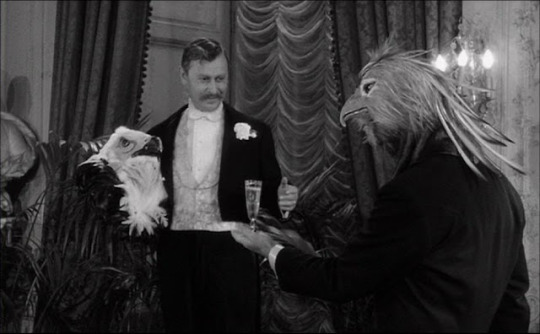
Michel Vitold and Channing Pollock in Judex (Georges Franju, 1963)
Cast: Channing Pollock, Francine Bergé, Edith Scob, Michel Vitold, Jacques Jouanneau, Théo Sarapo, Sylva Koscina. Screenplay: Jacques Champreux, Francis Lacassin, based on a screenplay by Arthur Bernède and Louis Feuillade. Cinematography: Marcel Fradetal. Art direction: Robert Giordani. Music: Maurice Jarre.
Judex is, like Steven Spielberg's Raiders of the Lost Ark (1981) and the subsequent Indiana Jones sequels, an hommage more than a spoof. In both cases, the filmmakers were affectionately mimicking films of their youth: the cliff-hanging serials that often accompanied feature films. Unlike Spielberg, director Georges Franju had a particular director in mind: Louis Feuillade, who crafted adventure thrillers usually involving master criminals like the titular protagonist of Fantômas (1913) and the sinister Irma Vep of Les Vampires (1915-16). The original Judex serial of 1916 featured a masked crime-fighter, a figure that became increasingly popular after Douglas Fairbanks adapted a magazine story in The Mark of Zorro (Fred Niblo, 1920), leading to numerous comic books and movies about swashbucklers and superheroes using disguises to protect their secret identity. The archetype became so prevalent that eventually it was subject to amused mockery, as in the camped-up Batman TV series of 1966-68. But Franju isn't out to mock Feuillade's serials so much as to recapture some of the innocent thrills of the original, with sets and costumes evoking a pre-World War I naïveté. Judex (Channing Pollock) is a do-gooder who in the film is trying to expose the fraud and murder committed by a wealthy banker, Favraux (Michel Vitol). He has somehow disguised himself (with an obvious fake beard) as Favraux's secretary, Vallières-- the film never bothers with backstories of its characters, so we don't know how Judex/Vallières gained Favraux's confidence and trust -- and manages to fake Favraux's death and hide him away in an elaborate dungeon, where he watches Favraux via an improbably early version of television. But Judex's plans -- which are not entirely clear in any case -- are complicated by his adversary, Diana Monti (Francine Bergé), who has herself been operating as the governess for Favraux's granddaughter. And so on, through an increasingly intricate series of plot twists, clashes, escapes, last-minute rescues, and all of the trappings of the genre. It's really a good deal of fun, though it occasionally goes a little slack, especially if you're not in the mood for such Gallic nostalgia. Marcel Fradetel's black-and-white cinematography mimics the silent-movie style to the mark, even using old-fashion iris shots for transition, and at one point having the comic-relief detective, Cocantin (Jacques Jouanneau), peer through the keyhole, with what he witnesses viewed through a keyhole-shaped aperture. Judex is played by an American magician, Channing Pollock, who performs some sleight-of-hand involving doves. A very handsome presence but no actor, Pollock was hyped as a new Rudolph Valentino, but without success.
1 note
·
View note
Text
THE INNER SHRINE
1913

The Inner Shrine is a four act play by Channing Pollock based on the 1909 novel of the same name by Basil King. The play was produced and directed by A.G. Delamater.
A bad woman turns good, but as a recent widow she finds her past a roadblock in terms of accepting remarriage.
One of the scenes in the play is set in Lakeville NJ, a fictional town which, according to critics, the characters pretentiously pronounced with as “LAKE-VEAL”.

The stage adaptation was first announced in January 1910, but the play laid dormant for three years before rehearsals began. In April 1913, it was announced that producer A.G. Delamater had acquired Pollack’s dust-covered adaptation. In the meantime, the play was produced by a stock company in Columbus OH. Delamater had vowed to begin a one dollar admission on Broadway with The Inner Shrine. He also promised to produce only morally upright plays.
"’The Inner Shrine' is not a Sunday school play. It is interesting, gripping, clean and founded on the novel of the same name. Channing Pollock wrote the play. Don't be afraid to bring your wife or daughter or mother. While the prices range from 25 cents to $1.50, the entire balcony will be sold at 50 cents. Matinee prices, 25 cents to $1.” ~ A.G. DELAMATER
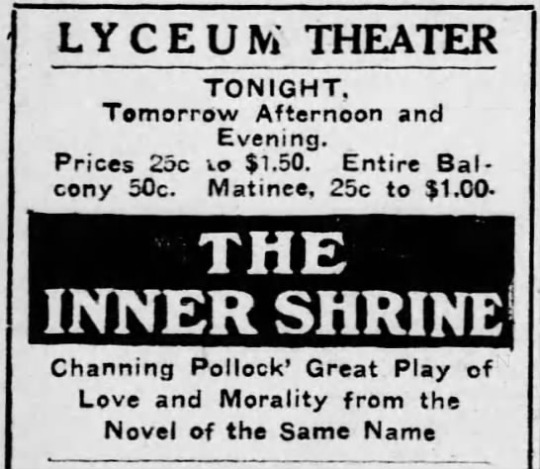
Delamater’s production of the play premiered at the Lyceum Theatre in Scranton PA on October 20, 1913. It played a split week with The Grand Theatre in Wilkes-Barre PA.

The play opened in Atlantic City on November 3, 1913 at Nixon’s Apollo Theatre on the Boardwalk. November 4, 1913 was Election Day, and it was advertised that returns would be read live from the stage between acts. The 1913 New Jersey gubernatorial election saw Democratic nominee James Fairman Fielder defeat Republican nominee Edward C. Stokes. The split week was shared with Harrisburg PA’s Majestic Theatre.
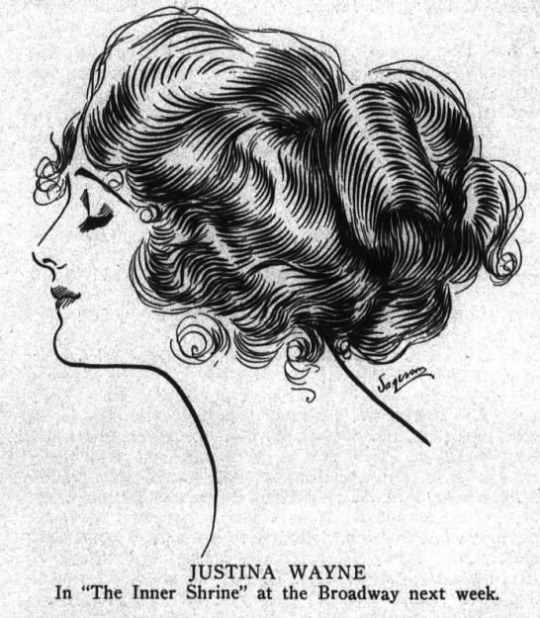
Next stop was Brooklyn’s Broadway Theatre (stress Brooklyn).

“[’The Inner Shrine’] came here only after It was refused admission at $1 prices at any Manhattan theaters. Alter seeing it, one finds little difficulty understanding why some of the Manhattan managers fought shy of this particular play. It is a cheap, poorly constructed, badly acted thing of no beauty of character or sincerity of purpose, and for the most part, it aroused mirth instead of tears with last night's audience at the Broadway.
Apart from the play itself, last night's performance was done by a second rate road cast that burlesqued, shouted and otherwise mistook noise for emotion and clever manipulation of the eyes for delicacy of characterization. There was absolutely no suggestion of the cultivated, cultured sort of people who lived in the novel.” ~ BROOKLYN DAILY EAGLE
“Channing Pollock turns out plays so numerously that, presumably, he writes them with both feet as well as with both hands.” ~ VANDERHAYDEN FYLES
With the harsh cynical eye of Brooklyn critics casting a negative pall over the ‘Shrine’ it is no wonder that Delamater verbally retaliated so emphatically.
"Broadway means nothing in my life. I have made my money with clean, back-to-the-land dramas that have never seen a New York opening. The verdict of a New York audience is not a criterion for the rest of the country. The great American stage must be saved from the rottenness of the New York manager. " ~ A.G. DELAMATER
Clearly the Broadway Theatre in Brooklyn would be the closest The Inner Shrine would get to the Broadway of Manhattan. In January 1914 the production played one final engagement far from the lights of the Great White Way - in Canada!

In 1917 Paramount released a silent film version of the novel without Pollock or Delamater’s participation. The film is now considered lost.

The film opened in Atlantic City on June 15, 1917 at the Colonial Theatre (Atlantic & New York Avenues).
#The Inner Shrine#Atlantic City#Nixon's Apollo Theatre#A.G. Delamater#Channing Pollock#Play#Theatre#Basil King#1913#Justina Wayne#Margaret Illington
1 note
·
View note
Text
@beatingheart-bride
"I don't know quite yet what he'll do," Dorian admitted with a small shrug. "I've told him that he has a place in our home and always will, but that he doesn't have to be a butler if he doesn't want to be. He's appreciated the offer, but he hasn't told me just what his plan is yet."
Still, he couldn't help but smile, resting his head against his hand as he commented, "I'm so glad he's coming with us. I...I want him to stay a part of my life, and I...I want him to be a part of the lives of any children Elizabeth and I have together. He is my family, and I want to treat him as such."
For once, Beau wouldn't have the task of essentially raising a child (as he largely had to do, given the absence of the Gracey parents, often leaving the child-rearing to the staff while they went about their day), wouldn't have to play the role of parent and pedagogue, but could instead be what he largely was to Dorian in his youth-a doting uncle. Out of all the staff at Gracey Manor, Beau was the one who cut his young charge the most slack, letting him out of his lessons a little earlier, willing to let him indulge in sweets and games when his parents weren't looking, as well as treating him not just as his charge and pupil, but as a young friend, who he fondly watched grow up. As such, Dorian quite liked the idea of Beau getting to do the same with his children, who too would no doubt look upon him fondly as "Uncle Beau"-only this time, they wouldn't be reprimanded for addressing him as such.
"And, of course, any children Lizzie and I have will have their grandmother as well," he grinned, adding, "I do believe Mrs. Henshaw is not only giddy at the idea of having a son-in-law, but also having a grandchild to spoil. Lizzie's told me she's a little apprehensive about moving, she's lived in Louisiana all her life, but...she's also excited about her family growing."
It had just been Mrs. Lena Henshaw and her daughter for a lot of years, ever since Mr. Henshaw's death in a farm accident on the Gracey property when Elizabeth was five. It was something else the elder Henshaw and Mrs. June Pace were able to bond over: Louisiana natives, looked down on as working widows, who still loved and missed their husbands, and did all they could to support their beloved children.
#((it's really nice-especially since 'metropolis' was edited without director fritz lang's permission))#((by american channing pollock who thought the film was too cerebral and heavy for u.s. audiences))#((and cut huge swathes of the film as a result; turning it into a muddled mess!))#((again; some of the footage was just too damaged to be restored and so the little gap is filled in))#((by a title card explaining what happened; but still; it's wonderful to see it near-fully restored!))#((and it's true; lost media does take a certain amount of luck; and it often seems to show up))#((in the most unexpected ways and in the most unusual places; and i think))#((if 'london after midnight' is found; i think it'll be very much a surprise))#((found in a VERY unusual place!))#((and yup; a little more of theda bara's 'cleopatra' has been recovered!))#((now there's another film that's been highly sought after and feared almost entirely lost))#((save for a scant few seconds! the newly-recovered footage isn't a huge amount))#((in terms of length; it's not like we have half the movie; but i'm not about to look a gift horse in the mouth))#((the fact that more has been found at all is HUGE!))#outofhatboxes#beatingheart-bride#V:Days of Future Past
5 notes
·
View notes
Text

#Home is the most popular#and will be the most enduring#of all earthly establishments. -Channing Pollock.#Want to invest in Dubai Real Estate Market?#Want to buy a home in Dubai?#Reach out to our specialist now.#☎ +971 52 955 2423#☎ +971-4 2500089#✉ [email protected]#🌐www.unitedestates.com#United Estates LLC Dubai#unitedestates#unitedproperties#propertymanagement#propertyinvestment#property#investment#invest#investinrealestate#roi#findhome#dreamhome#luxury#luxuryhomes#livingstyle#realestate#dubai#uae#emaar#damac
0 notes
Text

Saul Tepper (American, 1899-1987) - "Stage Door Schubert Theater" illustration for the story "Star Magic" by Channing Pollock (1933)

Norman Teeling (Irish, b. 1944) - Roger Casement shortly before his execution
131 notes
·
View notes
Text
youtube
The first proper trailer for Sonic Prime came out yesterday, as I'm sure you've all heard. I've gotten several messages asking me my thoughts, so... here's some thoughts! Thoughts on how the show's looking, and a certain bat whose presence is somehow the biggest news to me.
First off? This looks phenomenal, visually speaking. I'm kind of in awe of how good the visuals in CGI cartoons are getting. The scenery looks great. The characters move so fluidly. Everything's beautifully lit. I could go on and on. I wish the in-engine game cutscenes had animation half this good.
I continue to be pleased with how slavishly faithful to the games the main universe is - to the point that they're saying this is, in fact, just set in the game universe. Yeah, we're all getting tired of Green Hill Zone, but we've never had a cartoon that was this faithful. The closest we got was Sonic X, which I like, but it's hard to look at any random episode about Sonic having to save the extensive human cast from another generic robot and say it really has the feel of the games. Seeing Sonic and co. fight some classic Badniks in a cartoon with (mostly) their normal designs feels special after all these years of never quite getting that.
That slavish faithfulness to the classic iconography also makes the differences with the multiverse stuff hit harder, and thank GOD they're finally showing some of that. This teaser is pitching it as a show about Sonic meeting alternate timeline versions of his friends who form an underground resistance against the Eggman Empire (funny how the franchise keeps finding itself back in Freedom Fighter territory), which is fun and all. Tall cyborg Amy! A version of Tails who can walk like a spider on a set of robotic kitsune tails! Hell yeah! But if the synopsis blurbs about a "multiverse" and "new worlds" and that pile of leaked concept art from a year and a half ago are anything to go off of, this is presumably only the first of multiple alternate worlds that we'll be seeing. I'm very excited to see more of them!
We also hear a little more from the new voice cast. Brian Drummond is kinda doing his own thing with Eggman. I like it. It sounds compatible with the usual Mike Pollock take without aping it 1:1. He seems maybe a little more sinister here, which fits what we've seen so far from this take on Eggman. And Deven Mack still sounds great as Sonic, although I kind of wonder if he's being instructed to sound like Roger since the delivery in what we've heard so far is pretty similar. I get that desire for consistency, but I hope he's able to inject a bit more of his own spin on Sonic in the full show, even if it's supposed to technically be the same Sonic as Roger's.
Meanwhile, the roles for the rest of the main voice cast have been confirmed elsewhere, and they mostly match up with what I expected because these casting choices just make perfect sense. I already know Shannon Chan-Kent, known primarily for playing Misa in Death Note and Pinkie Pie's singing voice (and Smolder) in MLP, is perfect casting for Amy. Ashleigh Ball's one brief line as Tails sounds a lot like her Rainbow Dash voice, but like... hey, it fits! I'm excited to hear more from her. And Knuckles... well, I don't know his VA as well and also he has no lines in this trailer.
But by now y'all know which characters I stan the most, and you know what I'm gonna be excited about. The big surprise here is the fact that Rouge is on the main cast. The main cast.
The cast posters revealed that she was in the show, which was big enough news, but then the trailer drops and she's on the damn team. Every hero team in a kids' show needs three boys and two girls, and this time they rounded out the group with Rouge. AND she's being voiced by Kazumi Evans, yet another MLP alum on this show - this time Rarity's singing voice and the voice of Adagio Dazzle in Equestria Girls. I don't even need to hear any lines, I know that's another perfect fit.
I'm just shocked. Rouge hasn't been in a TV series in almost two decades since she was kept out of Boom, robbing us of the "Rouge somehow ropes Team Sonic into doing a goofy heist with her" episode the world deserved. Ian's even said that he pitched some ideas for Boom Rouge after being asked to pitch more Boom-ified game characters, but it went nowhere. While she's continued to show up in the comics and (to a lesser extent) the games due to her fan favorite status, it's kind of felt like she was being swept under the rug. Fewer major story appearances than in the '00s, not much merch, it took them until the fifth Mario & Sonic game to make her playable. And she's probably seen as less broadly marketable as a mascot character because of... well, two big reasons.
And so, understandably, Rouge is here with a new outfit that covers those two big reasons up more than usual.

Yeah as a Rouge fan, a person who's talked at length about the fanservice in Archie Sonic, and a sapphic furry artist, I can't avoid talking about this stuff lol
I mostly like the new outfit and think it was a smart call. We can have lots of nuanced discussions about objectification and sexual liberation and the fact that seeing some cleavage isn't gonna kill you and how being the flirty femme fatale is a core part of Rouge's character and whether that's objectifying or empowering and all the other things that get brought up every time a new Bayonetta game comes out. But at the end of the day their main audience is 8-year-olds, and because of that I really can't blame them for dressing Rouge slightly more modestly. I've always loved Rouge as a character the way she already is, but people (particularly non-fans, and also just... Sonic fans who aren't also furries lol) often write her off as "that weird bat lady with the tits that people are really horny for." Hopefully the writing will show non-comic readers that she's a genuinely fun character when used well as a foil to the rest of the cast, and hopefully her new outfit(s) will allow people to focus on that.
I do think something's a little off with the new outfit, though, even if I think it looks solid overall. Is it just that the heart motif is more abstract and less of a central focus here? That might be part of it. Maybe the suit just looks slightly overdesigned next to Team Sonic. Unsurprisingly I've also already seen multiple pieces of fanart giving this outfit a boob window, with one arguing that showing more of her skin tone on her torso gives the design better color balance, and... yeah, on that level I do kinda agree lol. Although I think a similar balance could be achieved just by having her upper arms be exposed or something. (Which is a feature on her bad timeline counterpart's outfit!) But, yeah, overall I do think I like it.
I also don't think they actually made her boobs smaller compared to most of her modern appearances despite the many, many, MANY claims to the contrary but I am not getting into that debate lol. Also she's literally still wearing a skintight catsuit and doing cool flying kicks you are not allowed to say they made her less hot
The fact that they're putting Rouge front and center has me VERY curious about her future prospects in the movie universe, though, given the particular projects currently in the works. To me, this makes it seem WAY more likely than it previously did. But who knows?
Uhhh anyway yeah the show looks good. I like pretty much everything we've seen so far. I like basically all of the previous Sonic cartoons except Underground to some extent, but if they stick the landing with this one then it seems like it'll pretty easily be the best one. I guess it's kinda lame that they made Sonic say "gotta go fast" in the trailer, but idk, it's a modern Sonic project, they gotta pay the obligatory lame meme toll. I am mostly fixated on Rouge because she's one of my favorite characters and her being on the main team is somehow the biggest curveball this show's previews have thrown so far, like seriously what.
235 notes
·
View notes
Text
La felicidad es una estación de parada en el camino entre lo demasiado y lo muy poco.
Channing Pollock

28 notes
·
View notes
Text
Ms. Pretty Rickey The Street Sweeper by Bryneen Gary

Book Summary:
Ms. Pretty Rickey: The Street Sweeper is a Force to Be Reckoned with, Infamous Poetry about Chief Officials, Freedom from War, Dirty Money, Narcotics Anonymous, World Affairs and Domestic Crimes. A Whisper of Sweet nothings, Fresh delights of Lasting Love in the mist of Terror’s Electronic Harassment and constant tracking through Satellite. Sweeping the Streets slowly through this short Poetic Book of Awareness
Buy the Book – Amazon
Reviews:
Resistance, Revolution and Other Love Stories by K. contains a series of short stories bound together by the theme of love during times of trouble. This anthology of stories is incredibly diverse and unique. K. soars above other authors with their sense of language, almost lyrically describing events in an abstractly beautiful way.
However, the prose is often so incredibly poetic that it was difficult for me to figure out what was actually happening. For instance, I had to read “Radius” multiple times in order to figure out what was going on with Mustapha’s brother, and I’m still not entirely sure I understood. There are so many abstract images painted to describe the story that are simultaneously poignant and senseless. During the portion describing Mustapha’s brother, I found myself squinting as if I were trying to decipher a Jackson Pollock painting. I knew it was beautiful, but I wasn’t sure exactly what it was.
Then it’s almost as if a different person picks up the pen to write “Calamity Jane,” wherein a teenage boy is exploring love and sexuality and the seemingly wanton need to tear down all women around him. It wasn’t a story that particularly resonated with me as a reader, mostly due to the amount of denigration focused on teenage girls throughout. The focus is on Jane, in particular, but also on any young girl who happens to wear yoga pants, who is thought of as an object in this young boy’s eyes. He constantly refers to them as “bitches,” and yet, he also constantly notes that they make his genitals “tingle.” If that made you cringe, perhaps skip this particular story. It strikes an ugly chord against the rest of the incredibly beautiful short stories.
In “Dog Whistle,” dogs are cruel in order to appease their masters, but with the touch of a gentle soul, realize the world around them is of their own making. Each story is so different in its own way and love truly ties them all together. I appreciate the different kinds of love woven throughout this story, not just pretty and romantic love. In “The Conversation,” familial love is explored, while in “Head Down,” a cheater falls in love. There were so many different voices within the book that it really felt fleshed out with untold ideas and unique stories. The stories were mostly very short and easy to read.
If you like philosophy, wistfulness, and the notion that love conquers all, this book will be a very enjoyable read for you.
Jenna Swartz, Seattle Book Review
"I think we’re destined to one day despise those quirks we once fell in love with."
From the opening tale, it is clear that this collection of twelve stories centering around love will be anything but conventional. Survivor's guilt devours the main character, Mustapha, who survives a bombing in Gaza that claims the lives of his neighbors and own brother, Khalid. In the privacy of his thoughts, he is unable to hide his attraction for Khalid's widow, Khalila, particularly knowing that the affection is reciprocated. However, outwardly he is resilient, thwarting any advances with the common statement that work needs to be done. The imagery of the fallen families, depicted by the metaphor of fallen branches, their limbs and bodies sprawled together yet mangled in every direction, is haunting. While love is central, the author's stories transcend beyond simple romance and dive into contextualized and developed worlds that add unique insight into what drives human behavior.
In "Calamity Jane," the author changes gears, delivering an attention-grabbing opening line: "Jane was a sweet girl once you got past the fact that she was a bitch." Simply put, the author has a knack for building characters that, while unorthodox, are irresistible and interesting. On the surface, this story could be perceived simply with the purely lust-filled lens of the on-again, off-again relationship of Jane and Jay. However, the perspective of Habib, the main character, provides a spin that is more focused on how much women are taken for granted in relationships. Needless to say, there are underlying themes to every story, albeit subtle, that impel audiences to spend a little more time unraveling the author's message.
As with Jane and Habib, the sexual tension is prevalent in numerous other stories. For example, in "The Hand," the main character is mesmerized by one of his supervisors, describing her moist lips and her black suit jacket as being "buttoned to just below her bust line; the silver buttons a fluvial shimmer against her white blouse." However, the Hand is strongly reminiscent of Orwell's Big Brother, always watching and controlling what memories are formed and even which memories can be kept (e.g., photographs).
On a similar yet different note, "The Conversation" features a blind character whose sexual tension with the pizza guy is palpable. But digging deeper, the reader can relate with her desire to be free from the shackles and constraints placed by her mother (who encourages Silvia to stay indoors) and the constant juxtaposition of what a parent perceives as protection with what the child feels is suffocation. Perhaps the most intriguing of the stories is "Head Down," where the instant attraction between Joseph and Shannon, both physically and from a personality standpoint, intersects with Joseph's tension in an unhappy marriage. A five-day information technology conference in Calgary turns into a whirlwind of passion and romance for the two with lingering effects.
From dystopian stories featuring Game of Thrones-esque great walls, an automaton with a mind of its own, and Greek mythology adaptations to inspired dogs inciting resistance and gardening being a metaphor for life, an element of the unexpected is embedded within each story. Undoubtedly eclectic, each selection takes on a life of its own with electrifying energy and the ability to incorporate themes that will keep ruminating in readers' minds long after the story is finished.
Mihir Shah, US Review of Books
About the author:
K., an anti-war advocate, studied English, Religion and Philosophy at University of Toronto and has written fiction for years, publishing several stories in literary magazines. Resistance, Revolution and Other Short Stories is K.’s first book. K. lives in Malton, Ontario, Canada, with their spouse, five children, an American Wirehair cat and a Quaker parrot.
2 notes
·
View notes
Text
Ms. Pretty Rickey The Street Sweeper by Bryneen Gary
Book Summary:
Ms. Pretty Rickey: The Street Sweeper is a Force to Be Reckoned with, Infamous Poetry about Chief Officials, Freedom from War, Dirty Money, Narcotics Anonymous, World Affairs and Domestic Crimes. A Whisper of Sweet nothings, Fresh delights of Lasting Love in the mist of Terror’s Electronic Harassment and constant tracking through Satellite. Sweeping the Streets slowly through this short Poetic Book of Awareness
Buy the Book – Amazon
Reviews:
Resistance, Revolution and Other Love Stories by K. contains a series of short stories bound together by the theme of love during times of trouble. This anthology of stories is incredibly diverse and unique. K. soars above other authors with their sense of language, almost lyrically describing events in an abstractly beautiful way.
However, the prose is often so incredibly poetic that it was difficult for me to figure out what was actually happening. For instance, I had to read “Radius” multiple times in order to figure out what was going on with Mustapha’s brother, and I’m still not entirely sure I understood. There are so many abstract images painted to describe the story that are simultaneously poignant and senseless. During the portion describing Mustapha’s brother, I found myself squinting as if I were trying to decipher a Jackson Pollock painting. I knew it was beautiful, but I wasn’t sure exactly what it was.
Then it’s almost as if a different person picks up the pen to write “Calamity Jane,” wherein a teenage boy is exploring love and sexuality and the seemingly wanton need to tear down all women around him. It wasn’t a story that particularly resonated with me as a reader, mostly due to the amount of denigration focused on teenage girls throughout. The focus is on Jane, in particular, but also on any young girl who happens to wear yoga pants, who is thought of as an object in this young boy’s eyes. He constantly refers to them as “bitches,” and yet, he also constantly notes that they make his genitals “tingle.” If that made you cringe, perhaps skip this particular story. It strikes an ugly chord against the rest of the incredibly beautiful short stories.
In “Dog Whistle,” dogs are cruel in order to appease their masters, but with the touch of a gentle soul, realize the world around them is of their own making. Each story is so different in its own way and love truly ties them all together. I appreciate the different kinds of love woven throughout this story, not just pretty and romantic love. In “The Conversation,” familial love is explored, while in “Head Down,” a cheater falls in love. There were so many different voices within the book that it really felt fleshed out with untold ideas and unique stories. The stories were mostly very short and easy to read.
If you like philosophy, wistfulness, and the notion that love conquers all, this book will be a very enjoyable read for you.
Jenna Swartz, Seattle Book Review
"I think we’re destined to one day despise those quirks we once fell in love with."
From the opening tale, it is clear that this collection of twelve stories centering around love will be anything but conventional. Survivor's guilt devours the main character, Mustapha, who survives a bombing in Gaza that claims the lives of his neighbors and own brother, Khalid. In the privacy of his thoughts, he is unable to hide his attraction for Khalid's widow, Khalila, particularly knowing that the affection is reciprocated. However, outwardly he is resilient, thwarting any advances with the common statement that work needs to be done. The imagery of the fallen families, depicted by the metaphor of fallen branches, their limbs and bodies sprawled together yet mangled in every direction, is haunting. While love is central, the author's stories transcend beyond simple romance and dive into contextualized and developed worlds that add unique insight into what drives human behavior.
In "Calamity Jane," the author changes gears, delivering an attention-grabbing opening line: "Jane was a sweet girl once you got past the fact that she was a bitch." Simply put, the author has a knack for building characters that, while unorthodox, are irresistible and interesting. On the surface, this story could be perceived simply with the purely lust-filled lens of the on-again, off-again relationship of Jane and Jay. However, the perspective of Habib, the main character, provides a spin that is more focused on how much women are taken for granted in relationships. Needless to say, there are underlying themes to every story, albeit subtle, that impel audiences to spend a little more time unraveling the author's message.
As with Jane and Habib, the sexual tension is prevalent in numerous other stories. For example, in "The Hand," the main character is mesmerized by one of his supervisors, describing her moist lips and her black suit jacket as being "buttoned to just below her bust line; the silver buttons a fluvial shimmer against her white blouse." However, the Hand is strongly reminiscent of Orwell's Big Brother, always watching and controlling what memories are formed and even which memories can be kept (e.g., photographs).
On a similar yet different note, "The Conversation" features a blind character whose sexual tension with the pizza guy is palpable. But digging deeper, the reader can relate with her desire to be free from the shackles and constraints placed by her mother (who encourages Silvia to stay indoors) and the constant juxtaposition of what a parent perceives as protection with what the child feels is suffocation. Perhaps the most intriguing of the stories is "Head Down," where the instant attraction between Joseph and Shannon, both physically and from a personality standpoint, intersects with Joseph's tension in an unhappy marriage. A five-day information technology conference in Calgary turns into a whirlwind of passion and romance for the two with lingering effects.
From dystopian stories featuring Game of Thrones-esque great walls, an automaton with a mind of its own, and Greek mythology adaptations to inspired dogs inciting resistance and gardening being a metaphor for life, an element of the unexpected is embedded within each story. Undoubtedly eclectic, each selection takes on a life of its own with electrifying energy and the ability to incorporate themes that will keep ruminating in readers' minds long after the story is finished.
Mihir Shah, US Review of Books
About the author:
K., an anti-war advocate, studied English, Religion and Philosophy at University of Toronto and has written fiction for years, publishing several stories in literary magazines. Resistance, Revolution and Other Short Stories is K.’s first book. K. lives in Malton, Ontario, Canada, with their spouse, five children, an American Wirehair cat and a Quaker parrot.
3 notes
·
View notes
Text
Ms. Pretty Rickey The Street Sweeper by Bryneen Gary

Book Summary:
Ms. Pretty Rickey: The Street Sweeper is a Force to Be Reckoned with, Infamous Poetry about Chief Officials, Freedom from War, Dirty Money, Narcotics Anonymous, World Affairs and Domestic Crimes. A Whisper of Sweet nothings, Fresh delights of Lasting Love in the mist of Terror’s Electronic Harassment and constant tracking through Satellite. Sweeping the Streets slowly through this short Poetic Book of Awareness
Buy the Book – Amazon
Reviews:
Resistance, Revolution and Other Love Stories by K. contains a series of short stories bound together by the theme of love during times of trouble. This anthology of stories is incredibly diverse and unique. K. soars above other authors with their sense of language, almost lyrically describing events in an abstractly beautiful way.
However, the prose is often so incredibly poetic that it was difficult for me to figure out what was actually happening. For instance, I had to read “Radius” multiple times in order to figure out what was going on with Mustapha’s brother, and I’m still not entirely sure I understood. There are so many abstract images painted to describe the story that are simultaneously poignant and senseless. During the portion describing Mustapha’s brother, I found myself squinting as if I were trying to decipher a Jackson Pollock painting. I knew it was beautiful, but I wasn’t sure exactly what it was.
Then it’s almost as if a different person picks up the pen to write “Calamity Jane,” wherein a teenage boy is exploring love and sexuality and the seemingly wanton need to tear down all women around him. It wasn’t a story that particularly resonated with me as a reader, mostly due to the amount of denigration focused on teenage girls throughout. The focus is on Jane, in particular, but also on any young girl who happens to wear yoga pants, who is thought of as an object in this young boy’s eyes. He constantly refers to them as “bitches,” and yet, he also constantly notes that they make his genitals “tingle.” If that made you cringe, perhaps skip this particular story. It strikes an ugly chord against the rest of the incredibly beautiful short stories.
In “Dog Whistle,” dogs are cruel in order to appease their masters, but with the touch of a gentle soul, realize the world around them is of their own making. Each story is so different in its own way and love truly ties them all together. I appreciate the different kinds of love woven throughout this story, not just pretty and romantic love. In “The Conversation,” familial love is explored, while in “Head Down,” a cheater falls in love. There were so many different voices within the book that it really felt fleshed out with untold ideas and unique stories. The stories were mostly very short and easy to read.
If you like philosophy, wistfulness, and the notion that love conquers all, this book will be a very enjoyable read for you.
Jenna Swartz, Seattle Book Review
"I think we’re destined to one day despise those quirks we once fell in love with."
From the opening tale, it is clear that this collection of twelve stories centering around love will be anything but conventional. Survivor's guilt devours the main character, Mustapha, who survives a bombing in Gaza that claims the lives of his neighbors and own brother, Khalid. In the privacy of his thoughts, he is unable to hide his attraction for Khalid's widow, Khalila, particularly knowing that the affection is reciprocated. However, outwardly he is resilient, thwarting any advances with the common statement that work needs to be done. The imagery of the fallen families, depicted by the metaphor of fallen branches, their limbs and bodies sprawled together yet mangled in every direction, is haunting. While love is central, the author's stories transcend beyond simple romance and dive into contextualized and developed worlds that add unique insight into what drives human behavior.
In "Calamity Jane," the author changes gears, delivering an attention-grabbing opening line: "Jane was a sweet girl once you got past the fact that she was a bitch." Simply put, the author has a knack for building characters that, while unorthodox, are irresistible and interesting. On the surface, this story could be perceived simply with the purely lust-filled lens of the on-again, off-again relationship of Jane and Jay. However, the perspective of Habib, the main character, provides a spin that is more focused on how much women are taken for granted in relationships. Needless to say, there are underlying themes to every story, albeit subtle, that impel audiences to spend a little more time unraveling the author's message.
As with Jane and Habib, the sexual tension is prevalent in numerous other stories. For example, in "The Hand," the main character is mesmerized by one of his supervisors, describing her moist lips and her black suit jacket as being "buttoned to just below her bust line; the silver buttons a fluvial shimmer against her white blouse." However, the Hand is strongly reminiscent of Orwell's Big Brother, always watching and controlling what memories are formed and even which memories can be kept (e.g., photographs).
On a similar yet different note, "The Conversation" features a blind character whose sexual tension with the pizza guy is palpable. But digging deeper, the reader can relate with her desire to be free from the shackles and constraints placed by her mother (who encourages Silvia to stay indoors) and the constant juxtaposition of what a parent perceives as protection with what the child feels is suffocation. Perhaps the most intriguing of the stories is "Head Down," where the instant attraction between Joseph and Shannon, both physically and from a personality standpoint, intersects with Joseph's tension in an unhappy marriage. A five-day information technology conference in Calgary turns into a whirlwind of passion and romance for the two with lingering effects.
From dystopian stories featuring Game of Thrones-esque great walls, an automaton with a mind of its own, and Greek mythology adaptations to inspired dogs inciting resistance and gardening being a metaphor for life, an element of the unexpected is embedded within each story. Undoubtedly eclectic, each selection takes on a life of its own with electrifying energy and the ability to incorporate themes that will keep ruminating in readers' minds long after the story is finished.
Mihir Shah, US Review of Books
youtube
About the author:
K., an anti-war advocate, studied English, Religion and Philosophy at University of Toronto and has written fiction for years, publishing several stories in literary magazines. Resistance, Revolution and Other Short Stories is K.’s first book. K. lives in Malton, Ontario, Canada, with their spouse, five children, an American Wirehair cat and a Quaker parrot.
4 notes
·
View notes
Text
A ROOM AT THE RITZ / THE SIGN ON THE DOOR
1919

A Room at the Ritz (later known as The Sign on the Door) was a melodrama in three acts and a prologue by Channing Pollock. It was originally produced by A.H. Woods and staged by Sam Forrest starring Mary Ryan, Lowell Sherman, and Lee Baker.
The play was also briefly known as The Moving Finger, although it was not performed under that title.
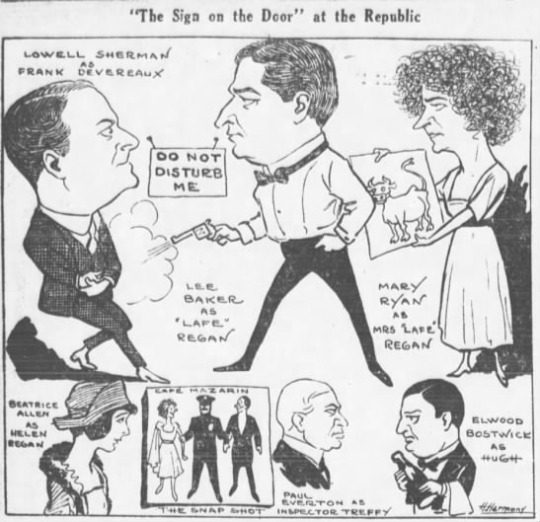
"Evening clothes, the world over, are the uniform of villainy." ~ Frank Devereaux in The Sign at the Door

The play takes place in a private supper room at the Café Mazarin, New York, the summer home of Lafe Regan in New Rochelle, and a room at the Ritz - a small apartment hotel in the 40′s.
THE STORY: While working as a stenographer, Ann Hunniwell only barely avoids being compromised by her boss's dissolute son, Frank Devereaux. Later on, she marries Lafe Regan, only discovering after they've wed that he knows Devereaux. Ann's stepdaughter, Helen, falls for Devereaux and makes plans to visit his apartment at the Ritz. Ann finds out about the date and heads over there first. But Regan shows up on some other business and is forced to shoot Devereaux in self-defense, while Ann hides. She uses circumstantial evidence to put the blame on herself and save her husband. Regan's self-defense plea, however, gets him off and the couple are left in peace.
The play’s original title, therefore, does not refer to the famous Ritz and Ritz-Carlton hotel chains. They were founded by Cesar Ritz, who had died in 1918. At the time, the US had two Ritz-Carlton hotels: in New York (1911), and Philadelphia (1913). Atlantic City’s Ritz-Carlton would open in 1921, two years after the play premiered there.
“The stage reputation of a hotel of the highest respectability seemed at stake for a few seconds last night In ‘The Sign on the Door,' which was presented for the first time In New York at the Republic Theatre, there was a sudden mention of the Ritz. There dwelt a famous philanderer. The audience pricked up its ears at such a fashionable sound. But the domicile of the villain - yes, he was especially villainous at home - turned out to be quite a different place of the same name.” ~ NEW YORK HERALD
“And ‘The Sign on the Door,' what did that mean? It was of three words, ‘Don't Disturb Me.’ They were In ink on a piece of note paper written by the villain to insure the peaceful pursuit of his plans. But they wero eventually hung on his door by the man who had shot him In the hope of creating the impression of suicide.” ~ NEW YORK HEARLD
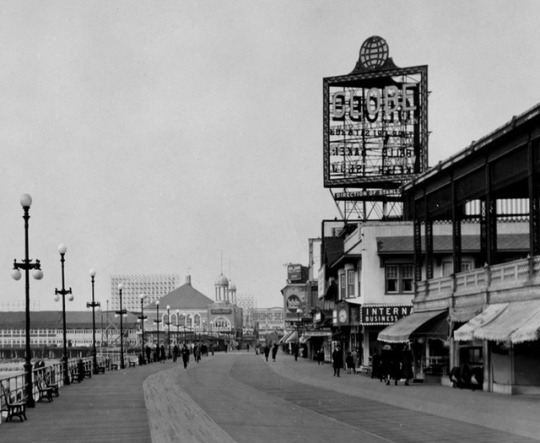
As A Room at the Ritz, the play opened in Atlantic City NJ at the Globe Theatre on the Boardwalk on December 15, 1919, just four days in advance of its Broadway premiere.
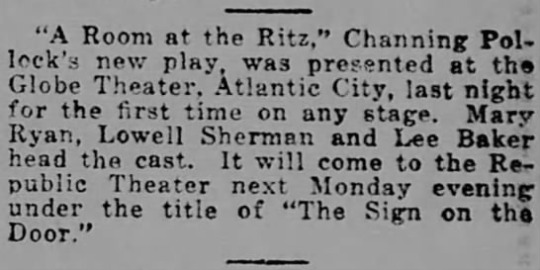
Quick (title) change on the road to Broadway.

Re-titled The Sign on the Door, it opened on Broadway on December 19, 1919 at Theatre Republic (now the New Victory) on 42nd Street.

The Sign on the Door is a 1921 silent drama film starring Norma Talmadge and Lew Cody. Actual dialogue from the theatrical production was used for the title cards, making them extremely wordy.

It opened in Atlantic City at the Virginia Theatre on the Boardwalk on October 1, 1921. By that time, there actually was “a room at the Ritz” - at the newly opened Ritz-Carlton Hotel on the Boardwalk and Iowa Avenue.

A second film adaptation of the play was released as The Locked Door (a 4th title!), starring Barbara Stanwyck and Rod LaRocque.

The film opened at the Stanley on the Boardwalk on November 15, 1929.
#A Room at the Ritz#The Locked Door#The Sign at the Door#Broadway#Broadway Play#Atlantic City#Globe Theatre#Mary Ryan#Stage#Theatre#Barbara Stanwyck#Lew Cody#Norma Talmadge
24 notes
·
View notes
Text
Here's a thought:
"A critic is a legless man who teaches running." - Channing Pollock

0 notes
Text

#Home is the most popular#and will be the most enduring#of all earthly establishments.#-Channing Pollock#Want to invest in Dubai Real Estate Market?#Want to buy a home in Dubai?#Reach out to our specialist now.#☎ +971 52 955 2423#☎ +971-4 2500089#✉ [email protected]#🌐www.unitedestates.com#United Estates LLC Dubai#unitedestates#unitedproperties#propertymanagement#propertyinvestment#property#investment#invest#investinrealestate#roi#findhome#dreamhome#luxury#luxuryhomes#livingstyle#realestate#dubai#uae#emaar
0 notes
Text
Ms. Pretty Rickey The Street Sweeper by Bryneen Gary
youtube
Book Summary:
Ms. Pretty Rickey: The Street Sweeper is a Force to Be Reckoned with, Infamous Poetry about Chief Officials, Freedom from War, Dirty Money, Narcotics Anonymous, World Affairs and Domestic Crimes. A Whisper of Sweet nothings, Fresh delights of Lasting Love in the mist of Terror’s Electronic Harassment and constant tracking through Satellite. Sweeping the Streets slowly through this short Poetic Book of Awareness
Buy the Book – Amazon
Reviews:
Resistance, Revolution and Other Love Stories by K. contains a series of short stories bound together by the theme of love during times of trouble. This anthology of stories is incredibly diverse and unique. K. soars above other authors with their sense of language, almost lyrically describing events in an abstractly beautiful way.
However, the prose is often so incredibly poetic that it was difficult for me to figure out what was actually happening. For instance, I had to read “Radius” multiple times in order to figure out what was going on with Mustapha’s brother, and I’m still not entirely sure I understood. There are so many abstract images painted to describe the story that are simultaneously poignant and senseless. During the portion describing Mustapha’s brother, I found myself squinting as if I were trying to decipher a Jackson Pollock painting. I knew it was beautiful, but I wasn’t sure exactly what it was.
Then it’s almost as if a different person picks up the pen to write “Calamity Jane,” wherein a teenage boy is exploring love and sexuality and the seemingly wanton need to tear down all women around him. It wasn’t a story that particularly resonated with me as a reader, mostly due to the amount of denigration focused on teenage girls throughout. The focus is on Jane, in particular, but also on any young girl who happens to wear yoga pants, who is thought of as an object in this young boy’s eyes. He constantly refers to them as “bitches,” and yet, he also constantly notes that they make his genitals “tingle.” If that made you cringe, perhaps skip this particular story. It strikes an ugly chord against the rest of the incredibly beautiful short stories.
In “Dog Whistle,” dogs are cruel in order to appease their masters, but with the touch of a gentle soul, realize the world around them is of their own making. Each story is so different in its own way and love truly ties them all together. I appreciate the different kinds of love woven throughout this story, not just pretty and romantic love. In “The Conversation,” familial love is explored, while in “Head Down,” a cheater falls in love. There were so many different voices within the book that it really felt fleshed out with untold ideas and unique stories. The stories were mostly very short and easy to read.
If you like philosophy, wistfulness, and the notion that love conquers all, this book will be a very enjoyable read for you.
Jenna Swartz, Seattle Book Review
"I think we’re destined to one day despise those quirks we once fell in love with."
From the opening tale, it is clear that this collection of twelve stories centering around love will be anything but conventional. Survivor's guilt devours the main character, Mustapha, who survives a bombing in Gaza that claims the lives of his neighbors and own brother, Khalid. In the privacy of his thoughts, he is unable to hide his attraction for Khalid's widow, Khalila, particularly knowing that the affection is reciprocated. However, outwardly he is resilient, thwarting any advances with the common statement that work needs to be done. The imagery of the fallen families, depicted by the metaphor of fallen branches, their limbs and bodies sprawled together yet mangled in every direction, is haunting. While love is central, the author's stories transcend beyond simple romance and dive into contextualized and developed worlds that add unique insight into what drives human behavior.
In "Calamity Jane," the author changes gears, delivering an attention-grabbing opening line: "Jane was a sweet girl once you got past the fact that she was a bitch." Simply put, the author has a knack for building characters that, while unorthodox, are irresistible and interesting. On the surface, this story could be perceived simply with the purely lust-filled lens of the on-again, off-again relationship of Jane and Jay. However, the perspective of Habib, the main character, provides a spin that is more focused on how much women are taken for granted in relationships. Needless to say, there are underlying themes to every story, albeit subtle, that impel audiences to spend a little more time unraveling the author's message.
As with Jane and Habib, the sexual tension is prevalent in numerous other stories. For example, in "The Hand," the main character is mesmerized by one of his supervisors, describing her moist lips and her black suit jacket as being "buttoned to just below her bust line; the silver buttons a fluvial shimmer against her white blouse." However, the Hand is strongly reminiscent of Orwell's Big Brother, always watching and controlling what memories are formed and even which memories can be kept (e.g., photographs).
On a similar yet different note, "The Conversation" features a blind character whose sexual tension with the pizza guy is palpable. But digging deeper, the reader can relate with her desire to be free from the shackles and constraints placed by her mother (who encourages Silvia to stay indoors) and the constant juxtaposition of what a parent perceives as protection with what the child feels is suffocation. Perhaps the most intriguing of the stories is "Head Down," where the instant attraction between Joseph and Shannon, both physically and from a personality standpoint, intersects with Joseph's tension in an unhappy marriage. A five-day information technology conference in Calgary turns into a whirlwind of passion and romance for the two with lingering effects.
From dystopian stories featuring Game of Thrones-esque great walls, an automaton with a mind of its own, and Greek mythology adaptations to inspired dogs inciting resistance and gardening being a metaphor for life, an element of the unexpected is embedded within each story. Undoubtedly eclectic, each selection takes on a life of its own with electrifying energy and the ability to incorporate themes that will keep ruminating in readers' minds long after the story is finished.
Mihir Shah, US Review of Books
About the author:
K., an anti-war advocate, studied English, Religion and Philosophy at University of Toronto and has written fiction for years, publishing several stories in literary magazines. Resistance, Revolution and Other Short Stories is K.’s first book. K. lives in Malton, Ontario, Canada, with their spouse, five children, an American Wirehair cat and a Quaker parrot.
0 notes